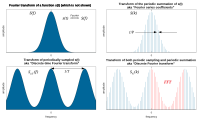
Photo from wikipedia
A Fourier telescope (FT) is an imaging system based on laser illumination and optical aperture synthesis and is suitable for imaging distant targets with high resolution through the atmosphere. The… Click to show full abstract
A Fourier telescope (FT) is an imaging system based on laser illumination and optical aperture synthesis and is suitable for imaging distant targets with high resolution through the atmosphere. The imaging time of a conventional FT is so long (about two hours) as to limit its practical applications. In order to shorten the imaging time of a Fourier telescope, we propose a new imaging system called the compressed sensing Fourier telescope (CS-FT). The image quality, the imaging time and the effects of noise of the new system are studied in detail. Based on the analysis, we find that by reasonably choosing the total sampling rate (TSR), the imaging time of the CS-FT is obviously shorter than that of the conventional FT while the image quality of the CS-FT is near that of the conventional FT. Worth noting is that with the smaller values of the low-frequency sampling rate (LSR) and the order of the sampling probability density function (OPDF), the CS-FT can achieve a better image quality. The reconstruction results of the field data show that the CS-FT can reduce the imaging time of a FT in an actual noise environment.
Journal Title: Journal of the Korean Physical Society
Year Published: 2019
Link to full text (if available)
Share on Social Media: Sign Up to like & get
recommendations!